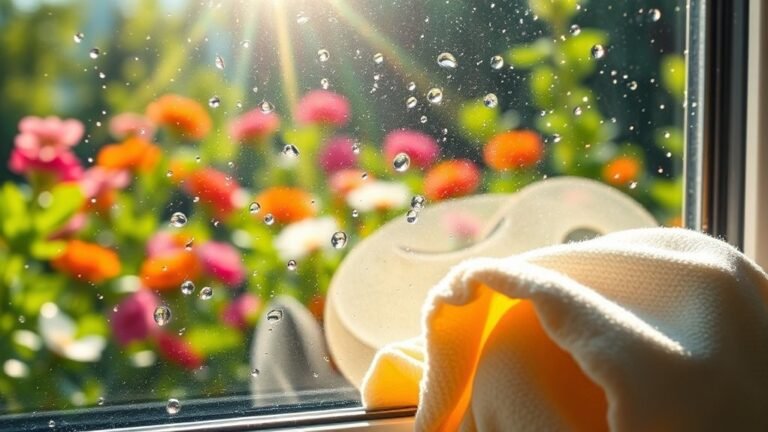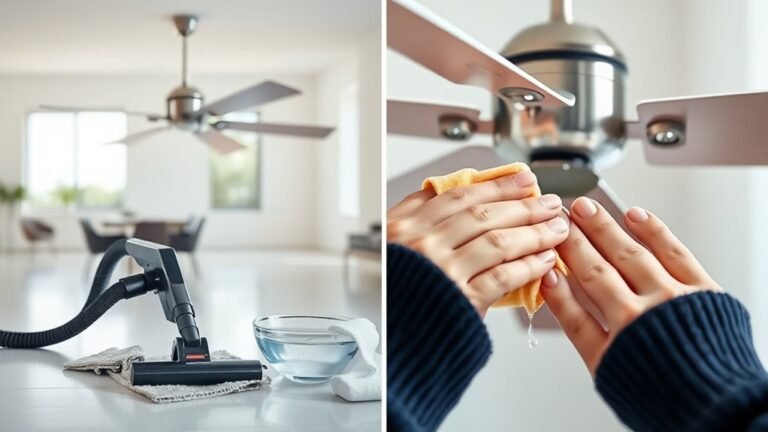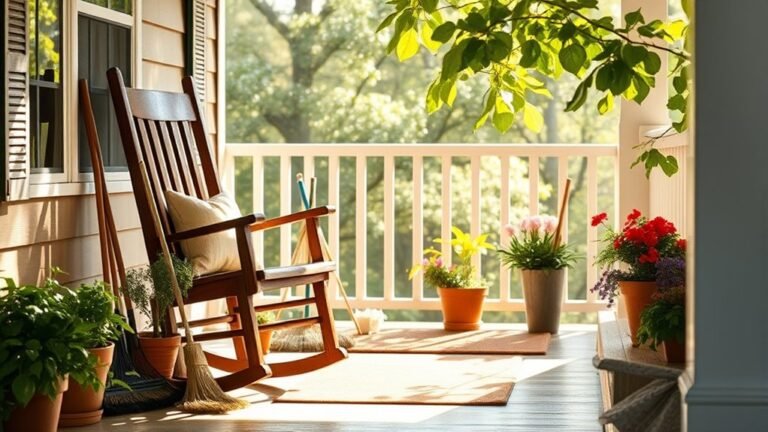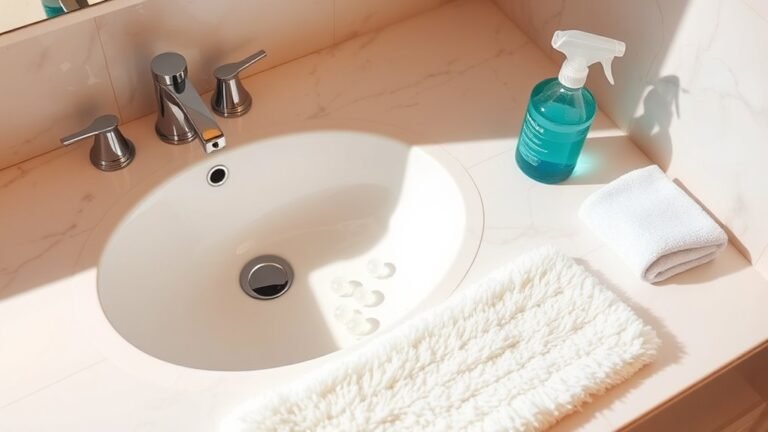Cleaning With Mold: What Works and What Doesn’T
When cleaning mold, you must first prioritize safety by wearing gloves, goggles, and a respirator to avoid exposure. Effective agents include vinegar, hydrogen peroxide, and commercial mold removers—bleach often fails, especially on porous materials. Remove heavily infested porous items and thoroughly scrub non-porous surfaces. Guarantee proper ventilation and dry surfaces completely to prevent regrowth. Ignoring these steps can worsen mold problems. Understanding these fundamentals helps you handle mold effectively and maintain a healthier home environment.
Understanding Mold and Its Risks
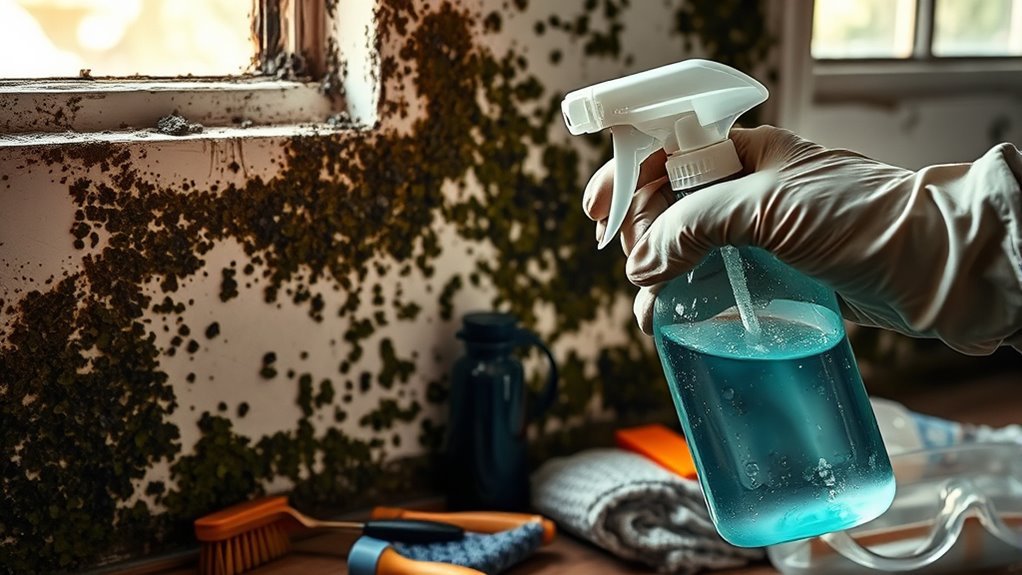
Although mold is a common household issue, many people don’t fully understand the health and structural risks it poses. You should know that mold biology involves fungi thriving in damp environments, releasing spores that can infiltrate your living space. These spores can trigger significant health effects, including allergic reactions, respiratory problems, and in severe cases, toxic responses. Additionally, mold growth compromises structural integrity by breaking down organic materials like wood and drywall, which can lead to costly damage if left untreated. Understanding these risks is essential for maintaining a safe, free environment in your home. By recognizing the biological nature of mold and its potential health impacts, you empower yourself to take informed, effective measures to protect your well-being and preserve your living space’s structural soundness.
Identifying Mold in Your Home
You need to recognize common mold types like black mold, Aspergillus, and Cladosporium to effectively identify contamination. Look for visible signs such as discoloration, fuzzy textures, or musty odors in damp areas. Early detection depends on understanding these markers and inspecting high-risk zones regularly.
Common Mold Types
Mold spores come in various species, each with distinct characteristics that affect their appearance, growth patterns, and health risks. When practicing mold identification, you’ll encounter common indoor mold types like black mold, notorious for its toxic mold properties and severe health effects. Mildew types generally appear powdery or fluffy and prefer damp, well-ventilated areas. Recognizing these differences is essential for effective moisture control and preventing mold proliferation. Black mold thrives in persistent moisture, releasing mycotoxins harmful to respiratory health. Understanding these mold varieties equips you to address contamination accurately and maintain a safe, free environment. Accurate mold identification streamlines your cleaning strategy, ensuring you’re tackling the right mold type without unnecessary exposure to harmful spores.
Visible Signs Detection
When moisture lingers unchecked, visible signs of mold often appear as discolored patches ranging from black and green to white and gray, typically on walls, ceilings, or around windows. To effectively identify mold in your home, you need to apply reliable mold detection techniques focusing on visible mold indicators. Look for:
- Irregular, fuzzy, or slimy textures on surfaces.
- Musty odors indicating hidden mold growth.
- Water stains or peeling paint signaling moisture issues.
- Persistent condensation on windows or pipes.
Essential Safety Precautions Before Cleaning Mold
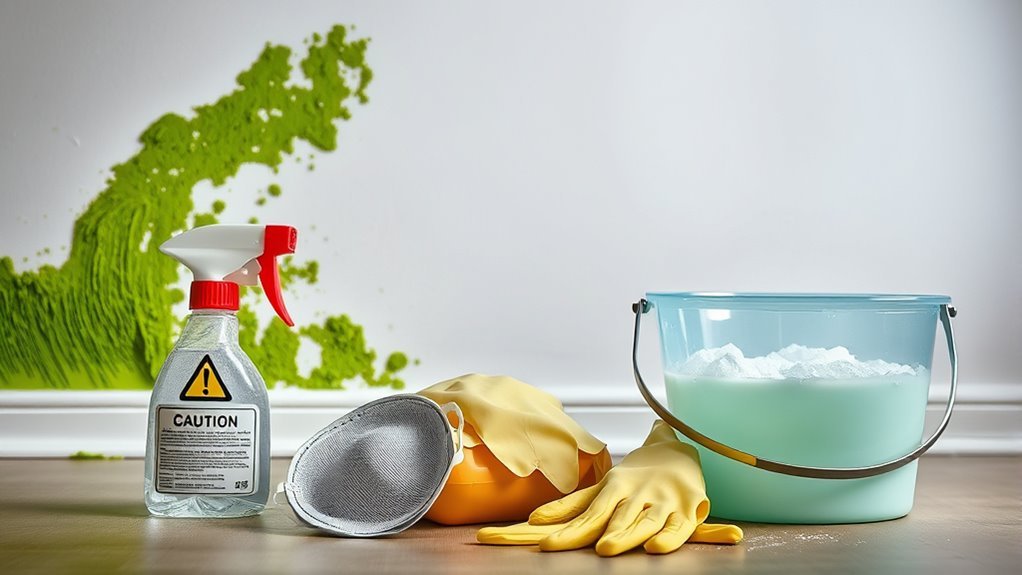
Before tackling mold cleanup, it’s crucial to prioritize your safety by equipping yourself with the proper protective gear and understanding the potential health risks involved. You should wear gloves, goggles, and an N95 respirator to prevent inhaling mold spores or contacting irritants. Confirm the work area is well-ventilated to reduce airborne exposure. Avoid disturbing mold without protection, as spores can trigger allergic reactions or respiratory issues. Use disposable materials when possible to contain contamination and prevent cross-spreading. Keep children, pets, and unprotected individuals away from the affected area during cleaning. By adhering to these safety precautions and using correct protective gear, you enable a controlled, safe cleaning process that minimizes health risks while effectively addressing the mold problem.
Effective Cleaning Agents for Mold Removal
Choosing the right cleaning agent is critical for effectively eliminating mold and preventing its recurrence. You’ll want to balance efficacy with safety and environmental impact. Both natural cleaning solutions and commercial mold removers offer distinct advantages depending on your needs. Consider these options:
- Vinegar: A natural cleaning solution that inhibits mold growth without harsh chemicals.
- Hydrogen Peroxide: Effective against mold spores, it disinfects and is less toxic than bleach.
- Commercial Mold Removers: Formulated with fungicides and biocides, these provide powerful, targeted mold elimination.
- Baking Soda: Mildly abrasive and natural, it deodorizes and absorbs moisture, reducing mold growth.
How to Properly Clean Moldy Surfaces

Properly cleaning moldy surfaces involves a series of controlled steps to guarantee complete removal and prevent regrowth. Start with thorough surface preparation: isolate the area, wear protective gear, and remove loose debris. Next, select appropriate mold removal techniques tailored to the surface material—non-porous surfaces respond well to biocidal cleaners, while porous materials may require specialized treatments or replacement. Apply cleaning agents evenly, allowing adequate dwell time for mold eradication. Use brushes or sponges with firm pressure to dislodge mold colonies without damaging the substrate. Rinse thoroughly to eliminate residues, then dry the surface completely to inhibit moisture retention. Maintain ventilation throughout to accelerate drying and reduce airborne spores. Following these precise steps guarantees effective mold remediation, safeguarding your environment and preserving your freedom from mold-related issues.
Common Mistakes to Avoid When Removing Mold
When removing mold, you shouldn’t rely on bleach incorrectly, as it may not eliminate mold spores effectively and can cause damage. You must follow strict safety precautions to protect yourself from harmful exposure. Additionally, skipping the removal of the mold’s source will only lead to recurring contamination.
Using Bleach Incorrectly
Although bleach is a powerful disinfectant, using it incorrectly can worsen mold problems or pose health risks. You must avoid relying on bleach for porous surfaces, as it only cleans the surface mold but leaves roots intact, leading to regrowth. Additionally, mixing bleach with ammonia or acids produces toxic fumes, which are dangerous. Here are common pitfalls when using bleach:
- Applying bleach to porous materials, resulting in ineffective solutions
- Overdiluting bleach, reducing its mold-killing efficacy
- Ignoring ventilation, increasing exposure to harmful bleach fumes
- Using bleach as the sole treatment, failing to remove mold’s root cause
Ignoring Safety Precautions
Since mold removal often involves harsh chemicals and disturbed spores, neglecting safety precautions can lead to serious health hazards and ineffective cleanup. You must always wear appropriate safety gear—such as gloves, goggles, and an N95 respirator—to minimize exposure to toxic mold spores and chemical irritants. Failing to do so increases your risk of respiratory issues, skin irritation, and allergic reactions. Additionally, inadequate ventilation during cleaning compounds these health risks by allowing airborne spores and fumes to accumulate. Ignoring safety protocols not only jeopardizes your well-being but also compromises the thoroughness of mold removal. To maintain control and protect your freedom to live safely, prioritize strict adherence to safety measures. This approach guarantees that you effectively eradicate mold while safeguarding your health throughout the process.
Skipping Mold Source Removal
If you don’t eliminate the mold’s source, your cleaning efforts will only provide a temporary fix. Skipping mold source removal means spores will continue to thrive, leading to recurring contamination. Effective mold removal methods must target the root cause, typically moisture intrusion or poor ventilation. To guarantee lasting results, focus on:
- Identifying and repairing leaks or water damage promptly
- Enhancing airflow to reduce humidity levels
- Using appropriate removal methods tailored to mold type and surface
- Discarding porous materials heavily infested with mold
Dealing With Mold on Porous vs. Non-Porous Materials
When tackling mold, understanding the difference between porous and non-porous materials is crucial because each type requires a distinct cleaning approach. Porous materials—like wood, drywall, and fabric—absorb moisture and mold spores deeply, making mold removal challenging. You’ll often need to discard heavily contaminated porous items since surface cleaning won’t reach mold embedded within. Non-porous surfaces, such as glass, metal, and plastic, don’t absorb moisture, so mold generally stays on the surface. For these, you can effectively clean mold using appropriate biocides or detergents. When cleaning non-porous surfaces, make sure you scrub thoroughly to remove all visible mold. Knowing this distinction empowers you to choose the right treatment method, saving time and preventing mold from recurring due to incomplete removal.
Preventing Mold Growth After Cleaning
After cleaning mold, you need to dry all surfaces completely to eliminate moisture that supports fungal growth. Controlling indoor humidity levels below 60% is essential to prevent mold spores from thriving. Proper ventilation guarantees air circulation, reducing dampness and further inhibiting mold development.
Drying Thoroughly Post-Cleaning
Although cleaning removes visible mold, thoroughly drying the area is critical to prevent mold from returning. Effective drying techniques and moisture control are essential components of post-cleaning protocol. You’ll want to verify no residual dampness remains, as mold thrives in moisture-rich environments.
To optimize drying and inhibit mold regrowth, consider these measures:
- Use high-efficiency fans or air movers to accelerate evaporation.
- Employ dehumidifiers to reduce ambient humidity levels in enclosed spaces.
- Remove or replace porous materials retaining moisture, such as carpets or drywall.
- Increase ventilation by opening windows or using exhaust fans to circulate air.
Controlling Indoor Humidity
Since mold growth is directly influenced by humidity levels, controlling indoor moisture is essential to preventing its recurrence after cleaning. Effective humidity control keeps relative humidity below 60%, ideally between 30-50%, to inhibit mold spores from thriving. You can achieve this by using dehumidifiers and moisture-absorbing materials, monitoring humidity with reliable hygrometers. Proper moisture management also involves promptly addressing leaks or water intrusion sources. Avoid excessive indoor water use without adequate drying measures. Maintaining consistent humidity levels stabilizes your living environment, reducing mold risks without compromising your freedom to use your space. This approach requires regular monitoring and adjustments to guarantee conditions remain unfavorable for mold. By prioritizing humidity control, you create a sustainable barrier against mold, supporting long-term indoor health and comfort after cleaning.
Ventilation Importance Explained
When you improve ventilation, you effectively reduce indoor moisture levels that mold needs to grow. Proper ventilation techniques are critical to maintain a dry environment and prevent mold regrowth after cleaning. You want to optimize air circulation to expel humid air and introduce fresh, dry air. Here are key strategies you can implement:
- Use exhaust fans in kitchens and bathrooms to remove moisture at the source
- Open windows regularly to promote natural air exchange
- Employ mechanical ventilation systems like HRVs or ERVs for controlled airflow
- Avoid blocking vents or air returns to guarantee unobstructed air movement
When to Call a Professional for Mold Remediation
How do you determine if mold growth requires professional remediation? If the affected area exceeds 10 square feet, or if mold recurs despite your cleaning efforts, it’s time to seek a professional assessment. Professionals can accurately identify hidden mold sources and assess contamination levels that might be invisible to the naked eye. Additionally, if you or your family experience persistent allergic reactions or respiratory issues, a thorough evaluation by experts is critical. Keep in mind, mold remediation costs vary depending on the extent and complexity of the infestation, but investing in professional services can prevent costly structural damage and health risks. When in doubt, prioritize safety and freedom from mold by entrusting the cleanup to certified specialists who use industry-grade equipment and protocols.
Long-Term Strategies to Keep Mold at Bay
Addressing mold issues promptly is important, but preventing future growth will save you time and resources in the long run. To maintain a mold-free environment, focus on long-term strategies that emphasize control and resistance. Implementing these practices guarantees your space remains healthy and unrestricted by mold concerns:
- Use mold resistant products during renovations or repairs to inhibit fungal growth on surfaces.
- Maintain strict humidity control by keeping indoor levels between 30-50% to reduce moisture availability.
- Ascertain proper ventilation in high-moisture areas such as bathrooms and kitchens to prevent condensation buildup.
- Regularly inspect and repair plumbing leaks or water intrusion points that could create damp conditions favorable to mold.
Frequently Asked Questions
Can Mold Cause Allergies or Respiratory Issues?
Yes, mold can definitely cause allergies or respiratory issues. You might experience mold symptoms like sneezing, coughing, or nasal congestion due to allergic reactions triggered by mold spores. If you’re sensitive, exposure can worsen asthma or other respiratory conditions. It’s important to identify and manage mold sources to protect your health and maintain freedom from these persistent symptoms. Staying informed helps you avoid prolonged exposure and its effects.
Is Mold Removal Covered by Homeowners Insurance?
Facing unexpected home challenges can feel overwhelming. When it comes to mold removal, mold coverage varies widely across insurance policies. Most standard homeowners insurance doesn’t cover mold damage caused by neglect or long-term moisture issues but may cover sudden, accidental water damage leading to mold. To guarantee freedom from surprise expenses, carefully review your policy’s mold coverage clauses and consider additional endorsements if necessary, so you’re prepared and protected.
How Quickly Does Mold Grow After Water Damage?
Mold growth can begin within 24 to 48 hours after water damage occurs. When moisture infiltrates your home, mold spores quickly find the damp environment ideal for reproduction. It’s essential that you address water damage immediately to prevent mold from establishing itself. By drying and ventilating affected areas swiftly, you reduce the risk of extensive mold growth, which can compromise your freedom to maintain a healthy, safe living space.
Are Natural Remedies Effective Against Mold?
Battling mold with natural solutions is like trying to tame a wildfire with a garden hose—sometimes it works, but often it’s not enough. When you compare effectiveness, natural remedies such as vinegar or tea tree oil can inhibit mold growth but rarely eradicate it completely. For thorough removal and lasting freedom from mold’s grasp, you’ll need stronger, proven agents like bleach or specialized fungicides, especially in severe infestations.
Can Pets Be Affected by Household Mold?
Yes, your pets can be affected by household mold. Mold exposure may compromise pet health, causing respiratory issues, allergic reactions, or skin irritation. Since pets often explore hidden areas, they’re more vulnerable to mold spores. It’s crucial to maintain a mold-free environment to protect their well-being. If you notice symptoms like coughing or sneezing in your pet, consult a veterinarian promptly to address potential mold-related health concerns.


